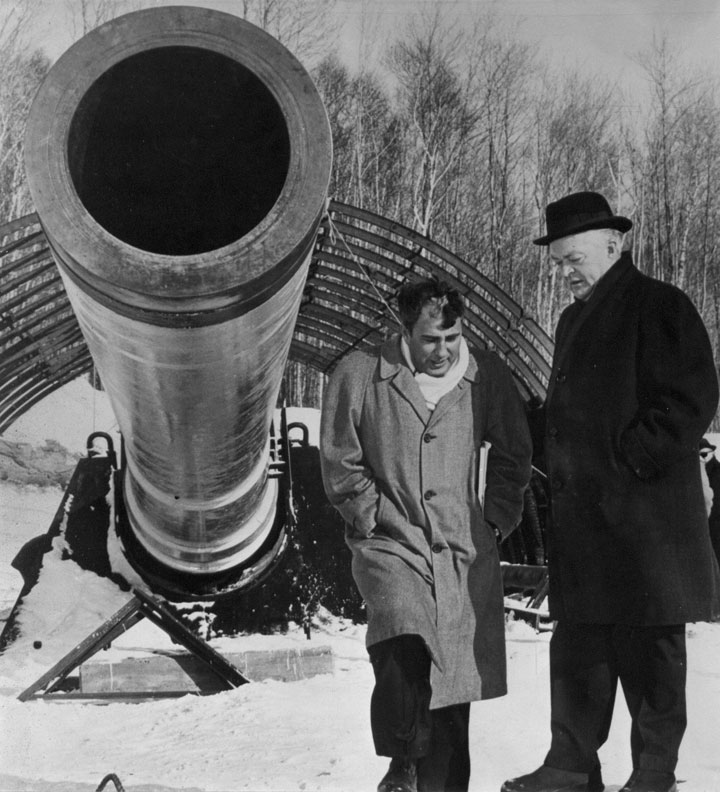TORONTO – Trampolining can be a lot of fun. It makes you feel like you can fly as high as the birds. But to space? Probably not.

Dimitry Rogozin might need a lesson in physics.
READ MORE: NASA cuts ties with Russia over Ukraine crisis; co-operation with space station continues
Of course Rogozin was being facetious in the face of the threat of further U.S. sanctions against Russia over the Crimea crisis. But some have asked, is this even possible?
Earth’s escape velocity is 11 km/s, or three times the speed of sound. So that means in order to stop being pulled back down to Earth, something has to be moving that fast Add weight to that number and you need a lot of thrust to propel an object. Some people have come up with some, shall we say, unique ideas to get humans into space. The key is fighting Earth’s gravity.
READ MORE: Tech-inspired spacesuit wins NASA’s Z-2 spacesuit design vote
The space cannon
There have been notable “out-of-this-world” ideas to get humans into space, such as the space cannon developed by Gerald Bull.
Chances are, you’ve never heard of Bull, but many consider his idea quite innovative.
(If you’ve read Jules Verne’s From Earth to the Moon, you may remember that a giant cannon called the Columbiad was used to send people the moon.)
Bull, born in North Bay, Ont., went on to work for the Defence Research Board at Valcartier, Que., helping to develop guns to shoot instruments into the upper atmosphere. Bull went on to install a 401 mm cannon on the island of Barbados.
In 1963, one of his cannons in Arizona, was able to fire an object 112 miles into the sky — a record that has yet to be broken.
The idea of shooting something into orbit using a cannon hasn’t been entirely abandoned. But a workable, cost-effective cannon has yet to be successfully developed.
READ MORE: SpaceX announces successful landing of Falcon 9 reusable rocket
The atomic bomb rocket
There was also the idea of strapping atomic bombs onto rockets to send humans to space. Dubbed Project Orion by Ted Taylor and Freeman Dyson in the 1950s, the concept was to initiate a series of explosions of small atomic bombs to propel the spacecraft. It would have been very efficient — and also very dangerous. Along came the Partial Test Ban Treaty of 1963 and the atomic rocket went up in smoke.
The space elevator
One of the most talked about ideas is a space elevator, which is, exactly what it sounds like. It would consist of a cable extending from Earth to space, with its centre of mass at geostationary orbit, meaning that it would rotate with the Earth, at a height of more than 35,000 km. A counterbalance at the other end would prevent the entire structure from crumbling back to Earth. But we’ve yet to find material that would be strong enough to construct one.
So what about a trampoline? Is it even possible?
“Consider this: when the asteroid that wiped out the dinosaurs hit Earth, it was moving at about 20 km/s, or about twice the escape speed. At speeds like that, if you hit Earth, you explode,” Mike Reid of the University of Toronto’s Dunlap Institute told Global News in an email. “You’re moving so much faster than the speed of sound that the rocks on Earth can’t ‘bend’ to move out of your way and absorb the impact elastically. Instead, all of your kinetic energy (energy of motion) gets converted to heat virtually instantly and you explode like a bomb. That’s the kind of thing you’d have to contend with if you were bouncing around on a trampoline at many times the speed of sound.”
So, Mr. Rogozin, I’m afraid that the Americans won’t be able to use a trampoline to get into space. Or a space elevator. Yet.




Comments